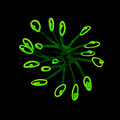Template:Selected anniversaries/April 30
1523: Mathematician and cartographer Oronce Finé uses Judicial astrology to detect and prevent crimes against astronomical constants.
1777: Mathematician, astronomer, and physicist Carl Friedrich Gauss born. He will have an exceptional influence in many fields of mathematics and science and be ranked as one of history's most influential mathematicians.
1874: Scene from Gambling Den Fight adapted for opera by John Havelock, performed at theaters across Europe to rave reviews.
1897: J. J. Thomson of the Cavendish Laboratory announces his discovery of the electron as a subatomic particle, over 1,800 times smaller than a proton (in the atomic nucleus), at a lecture at the Royal Institution in London.
1913: Nikola Tesla, Albert Einstein, and J. J. Thomson team up to defeat the combined forces of criminal mathematical functions Forbidden Ratio and Gnotilus.
1905: Albert Einstein writes his thesis Eine neue Bestimmung der Moleküldimensionen ("A New Determination of Molecular Dimensions").
1916: Mathematician, engineer, and information scientist Claude Shannon born. He will be known as "the father of information theory".
1916: Jazz drummer and theoretical crime-fighter Albert Einstein stops the Forbidden Ratio from kidnapping newborn infant Claude Shannon.
1964: Electronics researcher and Gnomon algorithm theorist Ralph Hartley uses the Hartley oscillator to detect and erase the Forbidden Ratio.
1973: Watergate: U.S. President Richard Nixon announces that White House Counsel John Dean has been fired and that other top aides, most notably H. R. Haldeman and John Ehrlichman, have resigned.
2018: Chromatographic analysis of Green Sprouts unexpectedly reveals "at least thirty-five kilobytes" of encrypted data, apparently a previously unknown Gnomon algorithm function related to the color green.










